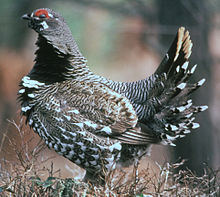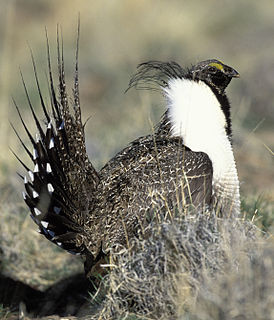
Grouse are a group of birds from the order Galliformes, in the family Phasianidae. Grouse are frequently assigned to the subfamily Tetraoninae or tribe Tetraonini, a classification supported by mitochondrial DNA sequence studies, and applied by the American Ornithologists' Union, ITIS, and others. Grouse inhabit temperate and subarctic regions of the Northern Hemisphere, from pine forests to moorland and mountainside, from 83°N to 28°N.

The Russian Far East is a region in North Asia which is coextensive with Russia’s easternmost territory, the Far Eastern Federal District, which is between Lake Baikal in Eastern Siberia and the Pacific Ocean.

The Phasianidae are a family of heavy, ground-living birds, which includes pheasants, partridges, junglefowl, chickens, turkeys, Old World quail, and peafowl. The family includes many of the most popular gamebirds. The family is a large one, and is occasionally broken up into two subfamilies, the Phasianinae and the Perdicinae. Sometimes, additional families and birds are treated as part of this family. For example, the American Ornithologists' Union includes the Tetraonidae (grouse), Numididae (guineafowl), and Meleagrididae (turkeys) as subfamilies in Phasianidae.

The black grouse, northern black grouse, Eurasian black grouse, blackgame, or blackcock, is a large game bird in the grouse family. It is a sedentary species, spanning across the Palearctic in moorland and steppe habitat when breeding, often near wooded areas. They will spend the winter perched in dense forests, feeding almost exclusively on the needles of conifers. The black grouse is one of 2 species of grouse in the genus Lyrurus, the other being the lesser-known Caucasian grouse.
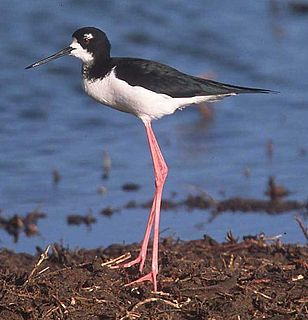
The Recurvirostridae are a family of birds in the wader suborder Charadrii. It contains two distinct groups of birds, the avocets and the stilts.

The willow ptarmigan is a bird in the grouse subfamily Tetraoninae of the pheasant family Phasianidae. It is also known as the willow grouse and in Ireland and Britain, where the subspecies L. l. scotica was previously considered to be a separate species, as the red grouse. It is a sedentary species, breeding in birch and other forests and moorlands in northern Europe, the tundra of Scandinavia, Siberia, Alaska and Canada, in particular in the provinces of Newfoundland and Labrador and Quebec. It is the state bird of Alaska. In the summer the birds are largely brown, with dappled plumage, but in the winter they are white with some black feathers in their tails. The species has remained little changed from the bird that roamed the tundra during the Pleistocene. Nesting takes place in the spring when clutches of four to ten eggs are laid in a scrape on the ground. The chicks are precocial and soon leave the nest. While they are young, both parents play a part in caring for them. The chicks eat insects and young plant growth while the adults are completely herbivorous, eating leaves, flowers, buds, seeds and berries during the summer and largely subsisting on the buds and twigs of willow and other dwarf shrubs and trees during the winter.

The spruce grouse or Canada grouse is a medium-sized grouse closely associated with the coniferous boreal forests or taiga of North America. It is one of the most arboreal grouse species, fairly well adapted to perching and moving about in trees. When approached by a predator, it relies on camouflage and immobility to an amazing degree, for example letting people come to within a few feet before finally taking flight, a behavior that has earned it the nickname "fool's hen".

The ruffed grouse is a medium-sized grouse occurring in forests from the Appalachian Mountains across Canada to Alaska. It is non-migratory. It is the only species in the genus Bonasa.

The genus Dendragapus contains two closely related species of grouse that have often been treated as a single variable taxon. The two species are the dusky grouse and the sooty grouse. In addition, the spruce grouse and Siberian grouse have been considered part of this genus.

The dusky grouse is a species of forest-dwelling grouse native to the Rocky Mountains in North America. It is closely related to the sooty grouse, and the two were previously considered a single species, the blue grouse.

The Caucasian grouse or Caucasian black grouse is a large bird in the grouse family. It is closely related to the black grouse.

The East Siberian taiga ecoregion, in the Taiga and boreal forests biome, is a very large biogeographic region in eastern Russia.

Lagopus is a small genus of birds in the grouse subfamily commonly known as ptarmigans. The genus contains three living species with numerous described subspecies, all living in tundra or cold upland areas.
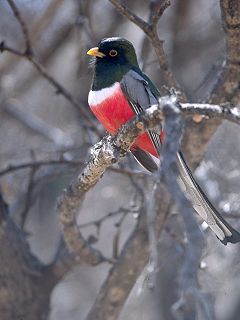
Trogon is a genus of Coraciimorphae birds in the trogon family. Its members occur in forests and woodlands of the Americas, ranging from southeastern Arizona to northern Argentina.

The Siberian grouse, Siberian spruce grouse, Amur grouse, or Asian spruce grouse, is a short, rotund forest-dwelling grouse. A sedentary, non-migratory bird, it is similar to the spruce grouse and Franklin's grouse of North America, which all belong to the genus Falcipennis.

The Chinese grouse, also known as Severtzov's grouse or the black-breasted hazel grouse is a grouse species closely related to the hazel grouse.
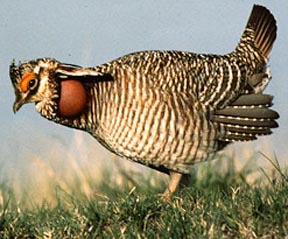
Tympanuchus is a small genus of birds in the grouse family. They are commonly referred to as prairie chickens. The genus contains three species:

Jacana is the genus comprising the two jacanas of the Americas: the northern jacana, Jacana spinosa, and the wattled jacana, Jacana jacana.

The Alberta–British Columbia foothills forests are a temperate coniferous forests ecoregion of Western Canada, as defined by the World Wildlife Fund (WWF) categorization system. This ecoregion borders Canada's taiga and contains a mix of subarctic forest and temperate forest species as a result. This makes the region an ecotone region, or a region that acts as a buffer between two other biomes.

Franklin's grouse is a subspecies of the spruce grouse found in British Columbia and the Rocky Mountains.
